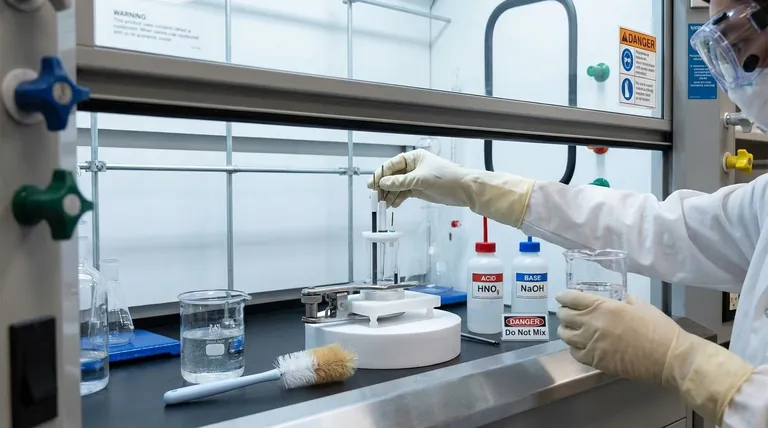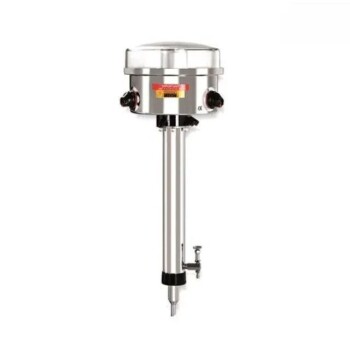Operating an electrolysis cell safely requires a multi-layered approach that addresses chemical exposure, equipment integrity, and procedural discipline. The primary safety measures include wearing personal protective equipment like gloves and glasses, operating within a fume hood to manage hazardous gases, and understanding the specific material limitations of the cell, particularly regarding heat and cleaning agents.
Your safety strategy must account for three distinct categories of risk: the chemical hazards posed by the electrolytes, the physical limitations of the cell's construction materials, and the procedural errors that can occur during operation and maintenance.

Managing Chemical Hazards
The electrolytes and gases involved in electrolysis represent the most immediate chemical risks. Proper containment and personal protection are non-negotiable.
Personal Protective Equipment (PPE)
When working with corrosive electrolytes, protective gloves and safety glasses are your first and most critical line of defense. This equipment protects your skin and eyes from direct contact and potential chemical burns.
Ventilation and Gas Management
Electrolysis can generate harmful or volatile gases. All operations should be conducted inside a fume hood to ensure proper ventilation and prevent the inhalation of these potentially toxic fumes.
Ensuring Equipment and Material Integrity
The physical components of the electrolysis cell have specific limitations. Exceeding these thermal or physical tolerances can lead to equipment failure and create a hazardous situation.
The Risk of Thermal Stress
The entire cell assembly must not be heated or sterilized. Different materials expand and react to heat differently. For example, the PTFE inner core may expand and not return to its original shape, while POM components can crack under high heat.
Proper Sterilization Protocol
If sterilization is required, only the glass body of the cell is designed to withstand high-pressure sterilization at 121℃. All other components must be removed before this process.
Common Pitfalls in Handling and Maintenance
Procedural errors during cleaning and maintenance are a frequent source of accidents and equipment damage. A disciplined approach is crucial.
Abrasive Cleaning Tools
Do not use metal brushes or other abrasive tools for cleaning. These can easily scratch the glass surface, creating weak points that could lead to fractures or breaks under pressure or thermal stress during operation.
The Danger of Mixing Cleaning Agents
Never mix different types of cleaning chemicals, particularly acids and bases (such as HNO₃ and NaOH). This combination can trigger a dangerous exothermic reaction, rapidly generating heat and potentially causing splashes or vessel failure.
A Practical Safety Checklist for Your Workflow
To integrate these principles effectively, consider the following during each phase of your work.
- If you are preparing for an experiment: Always verify the chemical compatibility and thermal limits of every cell component before beginning.
- If you are actively running the cell: Ensure you are using the correct PPE and that the fume hood is fully operational before introducing any current or reactants.
- If you are performing maintenance: Always use non-abrasive tools and never mix cleaning agents to preserve the long-term integrity and safety of the equipment.
A disciplined and informed approach is the foundation of safe and successful electrochemical experimentation.
Summary Table:
| Safety Category | Key Measures | Key Risks Mitigated |
|---|---|---|
| Chemical Hazards | Wear gloves and safety glasses; Operate within a fume hood. | Chemical burns, inhalation of toxic gases. |
| Equipment Integrity | Do not heat the entire cell; Sterilize only the glass body at 121°C. | Thermal stress, material deformation (PTFE/POM), cracks. |
| Handling & Maintenance | Use non-abrasive tools; Never mix acids and bases (e.g., HNO₃ & NaOH). | Glass scratches, exothermic reactions, splashes, vessel failure. |
Ensure your lab's electrolysis experiments are safe and efficient with equipment from KINTEK.
We specialize in providing reliable lab equipment and consumables designed with safety in mind. Whether you need durable electrolysis cells, fume hoods, or compatible PPE, KINTEK serves your laboratory's needs with products that meet rigorous safety standards.
Contact us today to discuss how our solutions can help you maintain a secure and productive lab environment. Let our experts guide you to the right equipment for your specific application.
Visual Guide

Related Products
- Electrolytic Electrochemical Cell for Coating Evaluation
- Customizable CO2 Reduction Flow Cell for NRR ORR and CO2RR Research
- Li-Air Battery Case for Battery Lab Applications
- Laboratory Hybrid Tissue Grinding Mill
- Desktop Fast Laboratory Autoclave Sterilizer 35L 50L 90L for Lab Use
People Also Ask
- What is corrosion in an electrochemical cell? Understanding the 4 Components of Metal Decay
- What type of experimental system is the all-quartz electrolytic cell designed for? Precision Electrochemistry in Demanding Environments
- What is the volume range of the coating evaluation electrolytic cell? A Guide to Choosing the Right Size
- What are the common applications of a flat plate corrosion electrolytic cell? Accelerate Material Testing & Research
- What is the difference between electrolytic corrosion cell and electrochemical corrosion cell? Understand the Driving Force Behind Corrosion



















